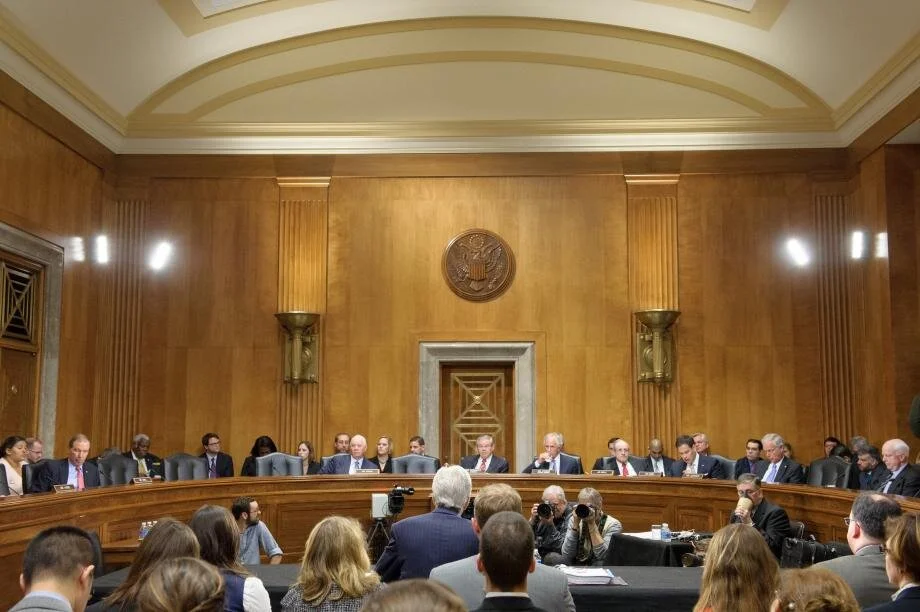Three concrete steps to improve the relationship between Capitol Hill and Foggy Bottom
By Ryan Dukeman | July 20, 2020 | Link to original article
“Cold.” “Toxic.” “Dysfunctional.” These are the words that come to mind when thinking of the relationship between Congress and the State Department, on matters of both foreign policy and management. For years, scholars and policymakers alike have bemoaned American diplomacy’s less-than-diplomatic approach to the first branch of government – a distrust that often cuts both ways, with legislators and staff conferring a degree of deference to the military and intelligence agencies they seldom accord to State.
From Congress’s perspective, this relationship results from a diplomatic apparatus that treats the Hill as a hall monitor to be kept at bay, rather than an involved, strategic constituency. (This institutional attitude has been supercharged and enforced under Secretary of State Mike Pompeo, who issued a blanket refusal for the Department to cooperate with Congress’s impeachment investigation). From State’s perspective, diplomats aren’t sufficiently resourced to approach the Hill relationship as much more than “feeding the beast,” putting out the immediate fire by responding to whatever request is next in the queue. State, for example, doesn’t have the staff or procedures to do a FYDP (Future Years Defense Program, pronounced “FID-ip”) equivalent, which would make it easier to get congressional buy-in by formally and explicitly tying budget projections to congressional and administration priorities over the long term.
Regardless of its source, the Capitol Hill-Foggy Bottom disconnect is bad for the civilian aspects of America’s foreign policy, and has proven remarkably persistent across Congresses and administrations. Rather than historically relitigate the sources of legislator-diplomat relations, I propose three concrete steps Congress and the executive branch could take to improve them going forward: integrating legislative diplomacy; turning annual reports into interactive dashboards; and the strategic production of diplomatic data.
Integrating legislative into traditional diplomacy
Much of my previous work, including here, has focused on “legislative diplomacy,” formal, peer-to-peer institutionalized networks between members of Congress and their foreign counterparts (e.g. the NATO Parliamentary Assembly) as well as agencies like the House Democracy Partnership that conduct parliamentary development operations overseas. Legislative diplomacy is an understudied aspect of America’s overseas role, and in select, targeted areas where the two branches can have a positive-sum relationship and Congress can add unique value, it can provide a comfortable benefit and extremely low cost.
Another aspect of legislative diplomacy, however, is the integration of members of Congress into internal executive-branch deliberations on key foreign policy issues, over which Congress retains an interest but to which it has largely delegated to the executive branch in recent decades. This “congressional advisory system” (for example, on trade, as well as on human rights in the Helsinki Commission and the Congressional-Executive Commission on China) has shaped executive-branch deliberation outcomes by nudging them in the direction of congressional preferences. This system also helped overcome Congress’s collective-action problems and incentives to delegate decisions, which reduce the legislature’s leadership role on headline foreign policymaking.
By and large, however, these advisory elements of legislative diplomacy have taken place outside of or in parallel to the State Department, where congressional involvement in foreign policy first (and too often, only) brings to mind CODELs, the often-derided but constitutionally important overseas “junkets” members and staff take to oversee US programs and meet with foreign leaders and civil society. A byproduct of State rightly being jealous and careful in guarding its foreign policy prerogatives (which have ceded too far to the NSC and DOD in recent decades), though, is that it has by-and-large not integrated members of Congress as active collaborators in its policymaking or diplomacy. This misses an opportunity to align institutional incentives and more actively create a congressional constituency for diplomacy – one that State could then call on when making the case for reclaiming civilian foreign policy functions from the military, for example, or asking for the resources needed to innovate.
Specifically, this could include the involvement of key administration allies in Congress in certain negotiations (conferring the type of close-friend-of-the-president legitimacy qualified political-appointee ambassadors bring), or the appointment of current members of Congress to advisory bodies like the Foreign Affairs Planning Board. Members of Congress routinely seek independent foreign policy thought-leadership opportunities in outside think tanks. Including the voices and opinions of these congressional foreign policy “entrepreneurs” inside the executive branch has led to interbranch cooperation on issues like trade and human rights in the past.
Overall, if the relationship between State and key members of Congress were less exclusively one of oversight and more one of involvement, the tenor of the relationship would become more positive on the margin, and incentives would improve for Congress and State to better trust each other.
From annual reports to continuous insight
Congressional staff complain constantly about the deluge of reports they receive from executive-branch agencies, dense, yearly PDFs often structured to make year-over-year comparison data hard to do (e.g. by using narrative text or screenshot images instead of machine-readable data tables). Yet these reports, of course, are mandated by Congress itself, and provide an opportunity for the Hill to understand both global trends and American diplomatic effectiveness. The question, then, is how to make the insights of these reports more accessible and actionable, and the answer can be found in the reports’ format and tempo rather than number.
During the pandemic, billions of people and nearly every news outlet in the world have turned to the Johns Hopkins COVID Dashboard for near-real-time, visually compelling, and insightful updates to “track the spread.” Imagine if this information came instead in the form of a typical agency report to Congress: rather than a dynamic dashboard any need-to-know member or staffer could access at a moment’s notice for insight and context, the COVID tracker would be a semi-annual Times New Roman memo running hundreds of pages and making country-to-country comparisons impossible to do with any speed.
State has begun to move in the direction of live dashboards on priority foreign policy issues, to the benefit of diplomats in the field, leaders on the 7th Floor, and overseers on the Hill alike. These efforts should be expanded, by State leadership and Congress mandating information in this format, and by Congress appropriately resourcing the Department to do so. In 2020, why should Congress and (where appropriate) the public wait a year to see State Department data on human rights, terrorism, or trafficking-in-persons, and then have to scan through hundreds of paragraphs across multiple PDFs to make basic comparisons across countries or years?
“What about context?” diplomats are likely to say, and they are right to. Diplomats excel at narrative analysis that synthesizes trends across social, political, and economic domains. This value-add, however, is too often sidelined by time spent writing up simple descriptives of “what happened” for such reports, rather than the much more important and interesting work of “why it happened”, “what we should or shouldn’t do about it”, and “has what we’ve tried in the past worked?” Fortunately, this critical analysis can be integrated into data visualization tools at the event level, allowing the user to click on a specific pin on the map, for example, and pull up more detailed, human-written reporting on the drivers and consequences of events, rather than simply describing the event itself in a long, narrative text.
State Department analysts and congressional staff would readily agree with each other that the current reporting system is not working: it overwhelms staff capacity to generate and utilize reports, fosters a “teach to the test” box-checking approach to legislative-diplomatic relations, and makes it hard for Congress, researchers, and the public to get trustworthy, machine-readable data from the State Department for important foreign policy analysis. Moving towards the model the public has become so accustomed to during COVID would be a benefit to both parties and to the public at large.
Data production to build a constituency
Kori Schake, author of State of Disrepair (Hoover, 2012), notes that while diplomats look with envy to the military’s (and its budget’s) natural constituency in Congress, in fact this ‘natural’ constituency is actively constructed. For example, the Defense Department produces reems of the original data both Congress and academic/think-tank analysts use to evaluate defense performance across a host of initiatives. This makes it easy for congressional overseers to see which programs are working, and more importantly which aren’t, when making funding and authorization decisions – at least relative to State, which has no equivalent original data-production function at scale. For example, amid concerns in the 1990s (and ongoing today) that US mutual-defense treaty allies weren’t paying their fair share, Congress tasked the Defense Department with creating several metrics on which to assess “Allied Contributions to the Common Defense,” in order to inform alliance management and policy debate over the future of US security alliances.
Had the State Department had the operational orientation and statistical capacity to do so, such an assessment likely would have been better a diplomatic than military task. Given policymakers’ typical view that NATO in particular represents an alliance of shared values and not simply a defense pact – i.e. that it forms the cornerstone of a broader, interconnected web of relationships between trans-Atlantic partners – understanding and integrating allied defense contributions in light of broader strategic foreign policy objectives would be more helpful for Congress and the administration. Such contextual, wide-aperture analysis of foreign policy is a clear comparative advantage for the State Department.
Strategic data production by the Defense Department extends far beyond tracking allies’ spending, and touches on myriad aspects of Defense budgeting, program evaluation, and acquisition decisions – in short, to make it easier for Pentagon and congressional leaders to understand which military programs are working and which are not.
What would strategic data production look like in the State Department? Well, for starters, diplomats could consider creating (and Congress could consider enabling the creation of) a Diplomatic Capacity Index, to understand and compare the performance of foreign ministries around the world, or metrics on the impact of principals’ engagement, i.e. on what issues are senior leaders like the Secretary personally involved and to what differential impact compared to delegating. (These data could be classified if absolutely necessary).
In State as in Defense, this is not to say strategic and transparent data production would be a silver bullet magically resolving internal bureaucratic rivalries. After all, the individual military services still fight fiercely to protect “their” programs even if DoD-level leadership would prefer them scrapped, and State’s regional and functional bureaus would likely (and rationally) do the same. But State’s work practices, and Congress’s resourcing of them, do not currently prioritize meaningful monitoring and evaluation (M&E) and strategic data production to build trust between diplomats and congressional overseers. This trust would be useful to State when the Department asks Congress for more funding for programs, by doing more to prove those efforts are working.
Conclusion
The unfortunate state of the relationship between Capitol Hill and Foggy Bottom is due to both structural and cultural factors on either side of the Mall. But fixing this relationship need not require herculean effort. By taking concrete steps like those outlined above, Congress and the executive branch can improve participation in and oversight of diplomacy, building better institutional trust and helping the State Department make its case to the Hill against much bigger competitors.



